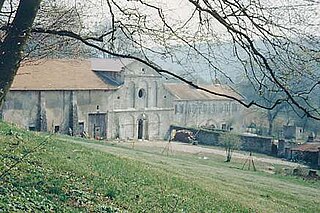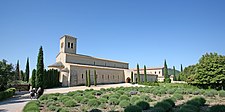
Le Barroux is a village and commune in the Vaucluse department in the Provence-Alpes-Côte d'Azur region in southeastern France. It had a population of 629 in 2017.

Vézelay is a commune in the department of Yonne in the north-central French region of Bourgogne-Franche-Comté. It is a defensible hill town famous for Vézelay Abbey. The town and its 11th-century Romanesque Basilica of St Magdalene are designated UNESCO World Heritage Sites.
Faremoutiers Abbey was an important Merovingian Benedictine nunnery in the present Seine-et-Marne department of France. It formed an important link between the Merovingian Frankish Empire and the southern Anglo-Saxon kingdoms of Kent and East Anglia.

The Solesmes Congregation is an association of monasteries within the Benedictine Confederation headed by the Abbey of Solesmes.

La Trappe Abbey, also known as La Grande Trappe, is a monastery in Soligny-la-Trappe, Orne, France. It is known for being the house of origin of the Trappists, to whom it gave its name.

Dom Gérard Calvet was a French Catholic abbot and founder of the Sainte Madeleine du Barroux abbey in Le Barroux, France. He was considered to be an important figure in contemporary Catholic traditionalism.

The Abbey of St. Mary of Lagrasse is a Romanesque abbey in Lagrasse, southern France, whose origins date to the 7th century. It is located in Languedoc, near the Corbières Massif, about 35 km from Carcassonne. It was originally a Benedictine monastery, but since 2004 has been home to a community of canons regular.

The Abbey of Saint-Sauveur-le-Vicomte, located in the commune of Saint-Sauveur-le-Vicomte in the Manche department of France, was a Benedictine monastery founded in the 11th century by Néel de Néhou, Vicomte of Saint-Sauveur. The abbey has longstanding connections with the nearby Channel Islands. After being dissolved in the French Revolution it became in the 1830s the mother house of the Sisters of Christian Schools of Mercy, now the Congregation of Saint Marie-Madeleine Postel.

The Abbey of St. Vincent, Laon was a Benedictine monastery in Laon, Picardy, northern France.

The Abbey of the Holy Trinity is an 11th century Romanesque Benedictine Abbey church located in Lessay, Manche, France, then in Normandy. The abbey is one of the most important Norman Romanesque churches, and, along with Durham Cathedral, one of the first examples use of the rib vault to cover the choir in about 1098. This element became a key feature of Gothic architecture. The abbey was nearly destroyed in 1357. It was destroyed in 1944 and subsequently rebuilt.

The Abbey of Saint-Seine is a former Benedictine monastery located in Saint-Seine-l'Abbaye, Côte-d'Or, Burgundy, France. During the Middle Ages it was a wealthy and powerful institution. It was suppressed at the French Revolution.

Dalon Abbey is a former Cistercian monastery in Sainte-Trie, Dordogne, southwestern France. It is listed as a Historic Monument.
Ardorel Abbey, formally the Abbey of Our Lady of Ardorel, was a Benedictine then Cistercian monastery located in the modern-day commune of Payrin-Augmontel, Tarn, southwestern France. It was destroyed during the Wars of Religion.

Solignac Abbey, or the Abbey of Saint-Peter and Saint Paul of Solignac, is an abbey in Solignac, near Limoges, in Haute-Vienne. It was founded around 631 AD by Saint Eligius (Éloi). The present buildings date to the 12th century, but have been modified many times since then. The abbey was dissolved during the French Revolution and the buildings were put to new uses, including a prison, boarding school, porcelain factory and seminary. As of 2021 there were plans to restore it back to its original function as a monastery.

The Abbey of Saint-Joseph de Clairval is a Benedictine abbey located in Flavigny-sur-Ozerain, in the Côte d'Or department. Founded in 1972, the abbey has no direct relationship with the Flavigny Abbey, which has not been occupied by Benedictine monks since the French Revolution. Belonging to the Olivetan branch, the monks wear the black bure and the white collar.

Sainte-Marie-au-Bois is a former abbey of the Premonstratensians order, located in the commune of Vilcey-sur-Trey, Meurthe-et-Moselle, France, built near a spring at the bottom of a small valley where a tributary of the Trey flows. Long considered the oldest settlement of the Premonstratensians order in Lorraine, its abbot in the early 17th century was Servais de Lairuelz, who led the reform of his order, first in Lorraine and then beyond. At the start of the First World War, French writer and poet Charles Péguy stayed at the former abbey, now a farm. Today, its remarkable remains make Sainte-Marie-au-Bois a rare architectural reminder of the Prémontré order in the 12th century.



















